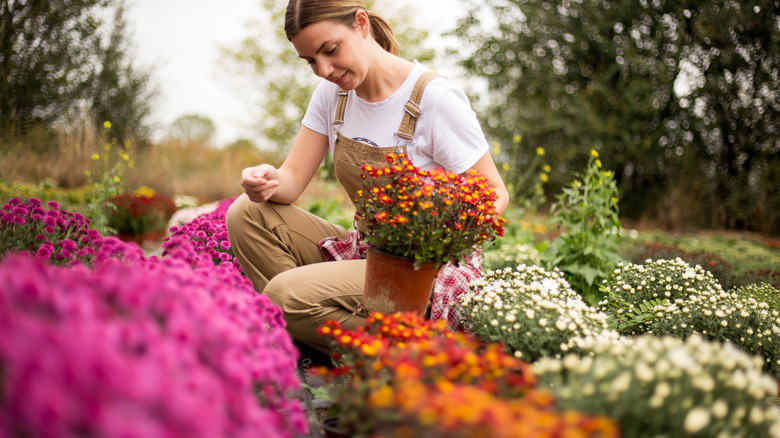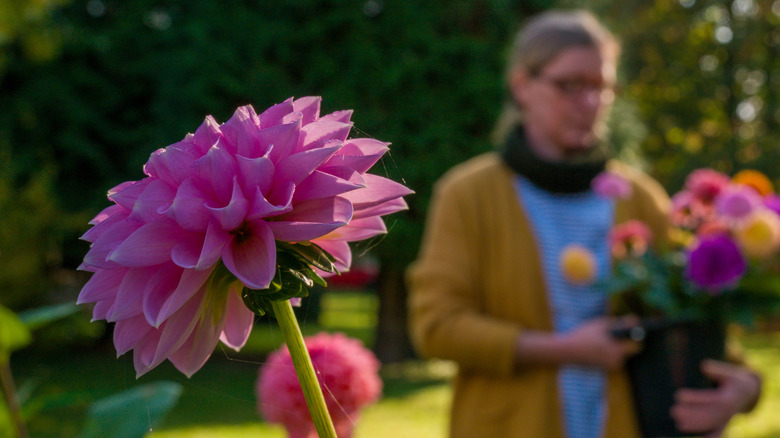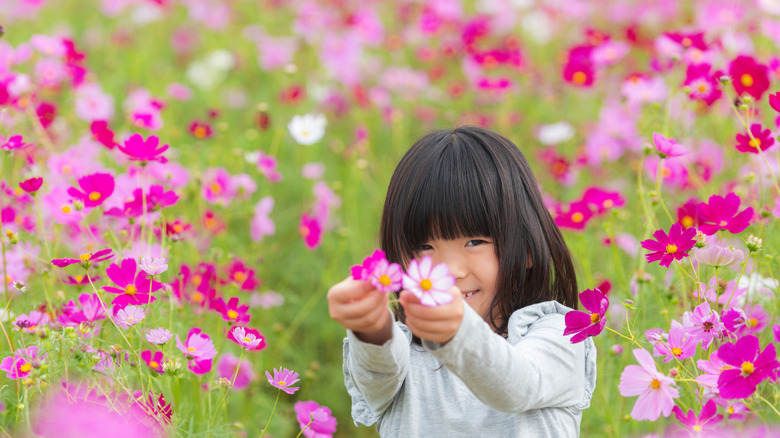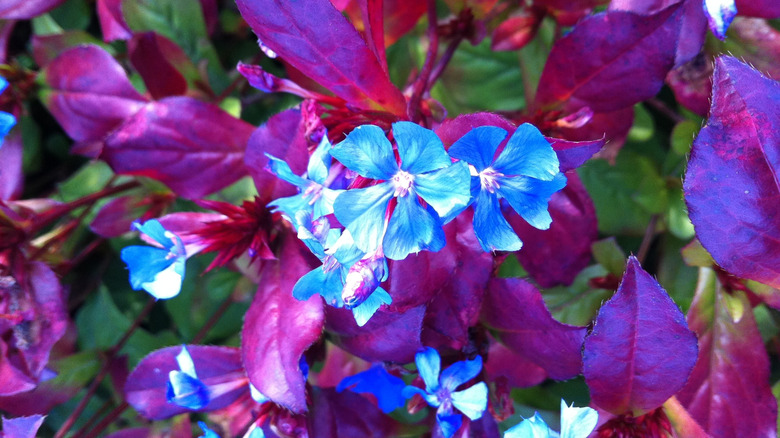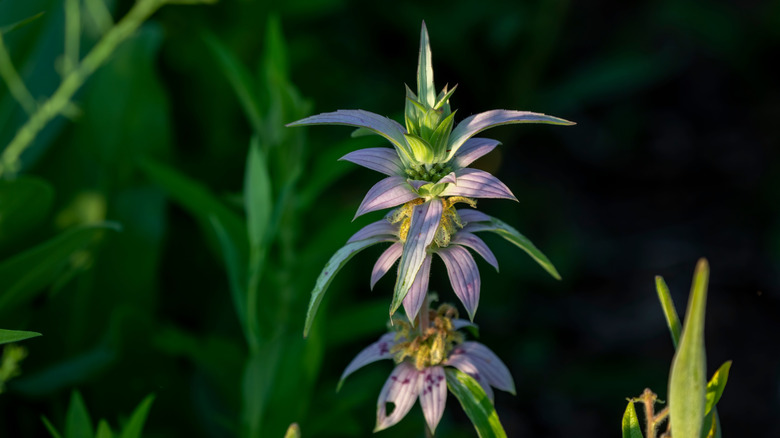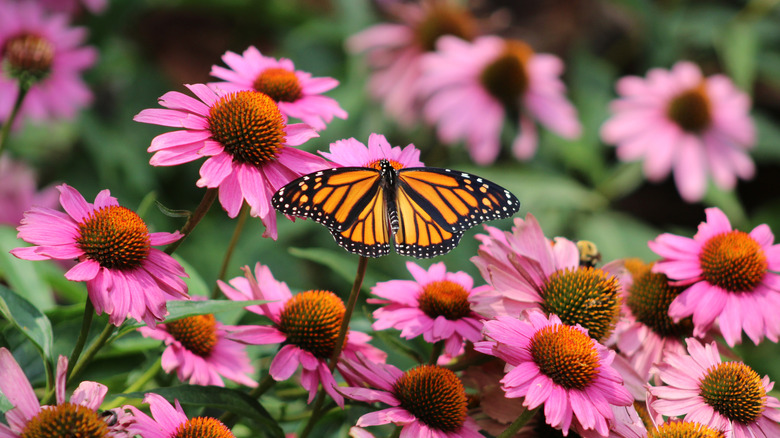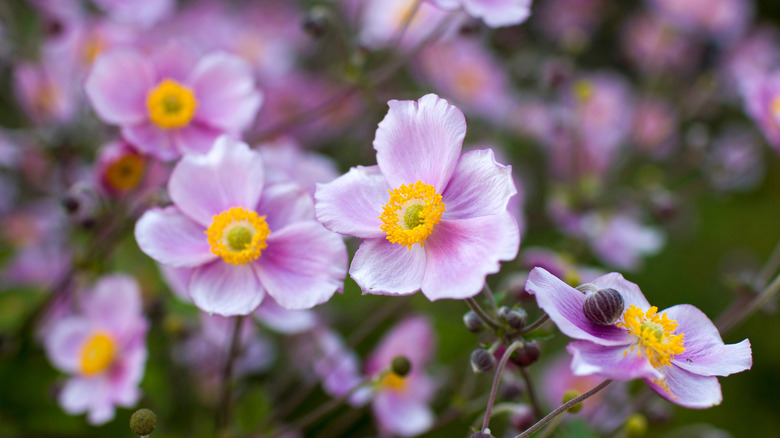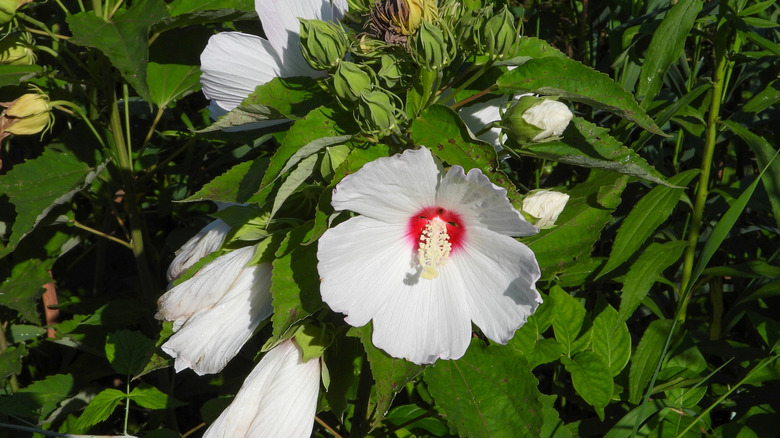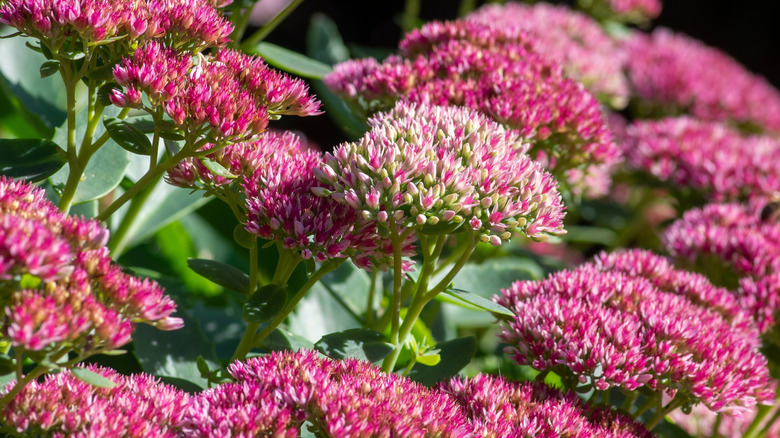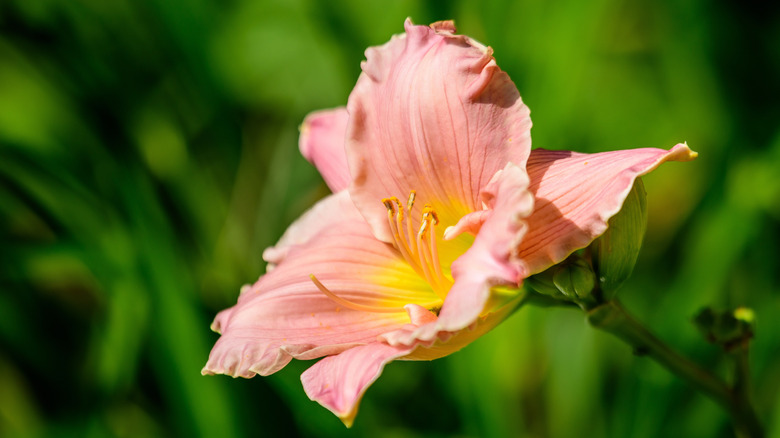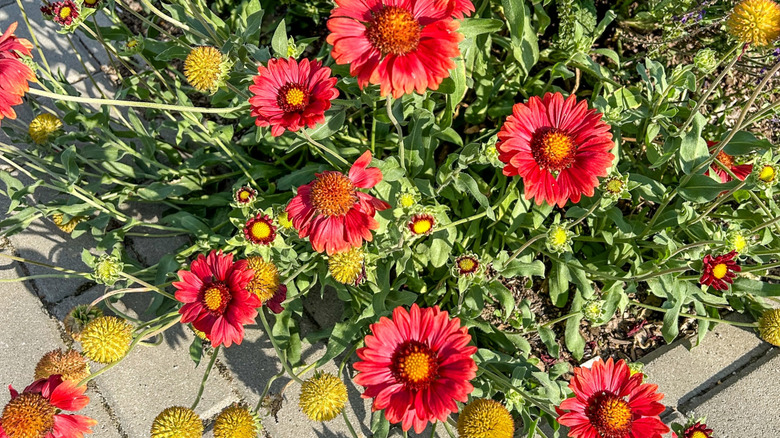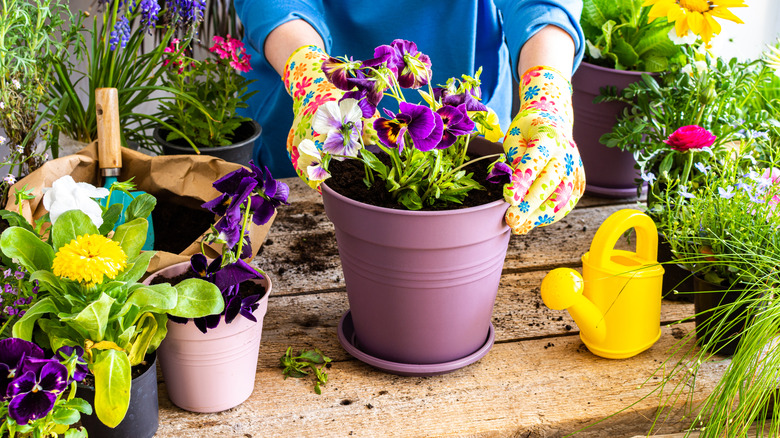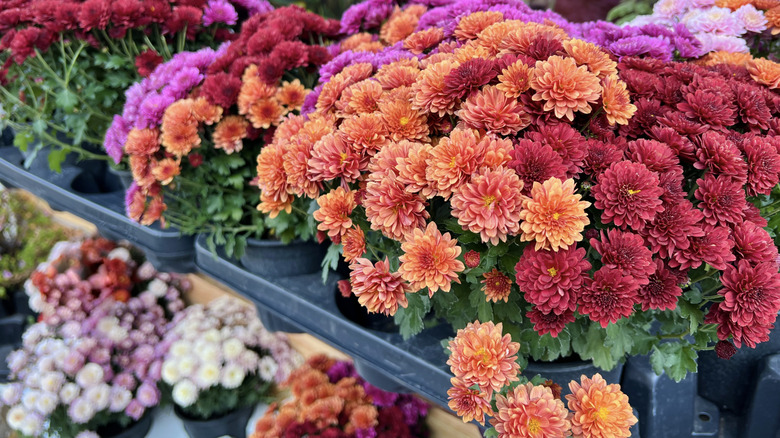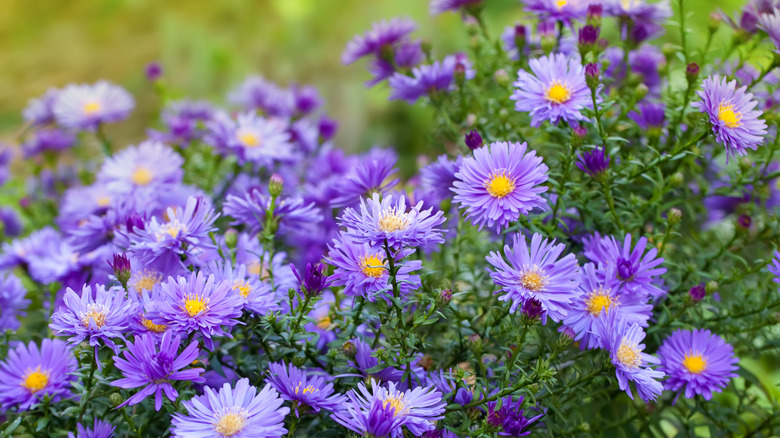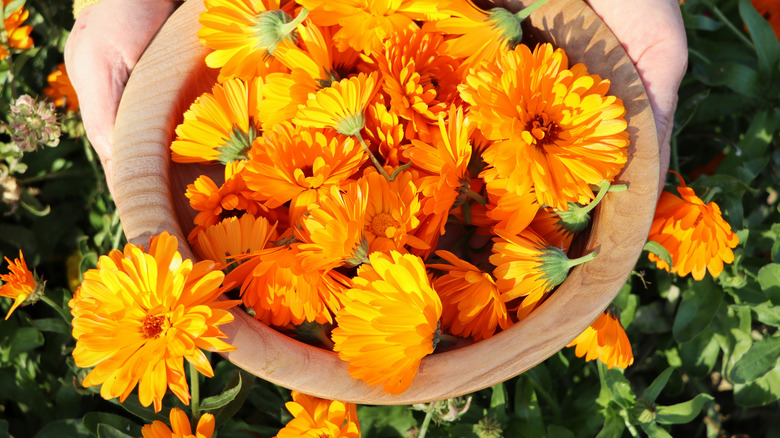15 Stunning Flowers To Plant In Late Summer For A Spectacular Fall Garden
We may receive a commission on purchases made from links.
While it seems like everyone is getting excited for pumpkin spice, some of us are still clutching summer with both hands, unwilling to let go of the gorgeous flowers that remind us of those lazy, hazy days. It doesn't have to end just yet. Perhaps you thought ahead by exploring which fall-blooming perennials bloom the latest. Acting accordingly, you may already have a few perennials in the ground ready to brighten your autumnal landscape, but we have you covered if you didn't get those perennials planted in time. If you're thinking about mums and pansies, hold on to your latte! That's just the beginning. We have pumpkin-colored calendula and cinnamon-hued blanketflower to add to the list, too!
There are many stunning flowers you can plant in late summer for a spectacular fall garden. Just seeing a cacophony of yellows, reds, corals, and pinks still blooming is enough to remind you that no matter how much clove and nutmeg are shaken all over the place, plants can still thrive if they are planted this time of year. We're not bloomin' ready to give up on the flowers just yet, so hold the pumpkin spice and get out the slow-release fertilizer!
Dahlias put on a big show
Hello, dahlia (Dahlia spp.)! (We couldn't resist saying that!) You won't be able to resist planting a lot of these sun-worshipping beauties since they're one of the 15 flowers perfect for a cut flower garden. Try to find a plant that's already flowering (dahlias come in a wide variety of colors and sizes), since they take upwards of a few months to bloom if you just plant the tubers. Dig up those tubers before the ground gets cold; they don't like to be chilly despite being hardy in USDA zones 7 through 10.
Coquettish cosmos will soon become a favorite
Cosmos is an enchanting flower with a daisy-like appearance that blooms in summer and fall. A cottage garden favorite and hardy in zones 2 to 11, it has delicate leaves that belie how tough the plant really is. It holds up to various soil types, handles part shade (though prefers at least 6 hours of sunshine), and doesn't mind heat. Find a blooming plant at a nursery if you can. You'll wait 7 to 21 days for germination and up to 60 days for them to flower if growing from seed. Cosmos is listed as an invasive in West Virginia; growing it there could harm local ecosystems.
The unforgettable blue flowers of leadwood
Blue flowers are special, and so is the stunning leadwood. The unforgettable ground cover with bright blue flowers against dark green leaves is often referred to as a blue leadwort or dwarf plumbago. If you're in the market for the sun-lover, check it out carefully to be sure it has the scientific name Ceratostigma plumbaginoides, since other plants have similar-sounding common names. Thriving in USDA hardiness zones 5 through 9, they'll bloom until mid-fall if you order a live plant from a nursery; shipping starts early September, for example, for zone 5 gardeners.
Attract late-season pollinators with spotted beebalm
Give butterflies and honeybees a fall boost of nutrition by planting spotted beebalm (Monarda punctata). It starts blooming towards the end of summer and continues to flower into fall. This speckled flowering plant is hardy in zones 4 through 9 and will tolerate anything but very soggy soil. It grows well in either part-sun or full sun and reaches heights of up to 2 feet. If growing it from seed, spotted beebalm won't bloom the same year unless you plant it in the spring. So, try to find this plant at a nursery.
You'll feel better about planting coneflower
If you've been following homeopathic remedies in recent years, you'll know that the Eastern purple coneflower is becoming very well-known by its scientific name, Echinacea, which may have properties that aid in avoiding or ameliorating colds and other respiratory infections. Great! And they're hardy in zones 3 to 8? We'll take two live Clovers Garden Purple Coneflower plants and plant them in late summer, so that we have blooms into the fall! Give them some mulch when it gets colder. As the flowers die back when the frost hits, cut the stems down to the soil so they go dormant.
Gorgeous Japanese anemone
We bow to the beauty of all anemones, which paper the landscape in a variety of colors and sizes. Japanese anemone (Eriocapitella x hybrida) may be the late-blooming summer flower you still have time to grow in your garden, but it's still tricky to grow in colder climates, despite hardiness in zones 3 to 8. Tuck Japanese anemones into moist soil that drains well, be sure they're in a sunny spot (they'll tolerate some shade), and make sure the soil has neutral pH. Watch out, though; all parts are toxic to people if eaten in large amounts; some may also be sensitive to its sap.
Rose mallow makes your garden look like a tropical oasis
The big, sprawling blooms of the crimsoneyed rose mallow (Hibiscus moscheutos) will make you think you're on a tropical island after you plant it in late summer. Also known as the swamp mallow, this flower with a wow factor likes ground that is a little wetter than most of the other featured fall flowers. Its white-to-pink flowers will beckon butterflies while it blooms into the fall in the somewhat warmer hardiness zones of 5 through 9. Give this one room; it will spread 2 to 4 feet wide and 3 to 7 feet tall.
Let sedum rock your fall plantings
A familiar sight in rock gardens or tumbling over walls, sedum or stonecrop, as some folks call it, makes up for its low height with an abundance of varieties to delight you. Some look like the succulents they are and sport leaves or flowers dressed up in a rainbow of shades, while one looks like a blue spruce! Plant sedums (hardy in zones 3 to 9) as late as the end of summer; if you can find blooming plants at the nursery, their flowers will stay on through fall.
Cheerful daylilies will wake up fall flower beds
Did you know that many varieties of daylilies (Hemerocallis spp.) can be planted and will bloom as long as they're in the ground about a month and a half before the first frost? Choose a sunny spot, add some fertilizer to the area where you want to plant them, tuck in the daylilies so that the crown is buried about an inch below the surface, then give them a good, long drink of water. With enough time and good growing conditions in zones 3 to 9, daylilies like 'Pink Playmate' will brighten the landscape before winter hits.
Warm up to blanketflower for a fall flower display
The bold magenta, gold, and maroon shades of blanketflower (Gaillardia spp.) practically shout, "HELLO, AUTUMN!" It's hardy in zones 3 to 9, but you'll need to be in an area with mild winters if you plant it in late summer. If you live where it's colder and can find a blanketflower that's already blooming, give it a try in a sunny part of your garden. Before the weather turns too cold, tuck in it for the winter some mulch. It should return next year, and its seeds may provide you with extra plants.
Pansies aren't just for spring
If pansies (Viola x wittrokiana) were human, they'd be the tough guys on the block. A surprise overnight dusting of snow? Who cares, says the pansy! They'll poke their "faces" through the snow in a flowerpot, laugh at the flakes, turn toward the sun, and dare you to think they aren't the beautiful flower you can plant now for colorful blooms that last into winter. Weather and your hardiness zone determine the growth and bloom potential of pansies in the fall (they're hardy in zones 6 to 10). Give them direct sunlight, well-draining soil, light mulch, and a bit of fertilizer.
Everybody's fall favorite: chrysanthemum
It almost wouldn't be fall without chrysanthemums. The perennial thrives in hardiness zones 3 to 9 and seems to be available just about everywhere, from outside neighborhood grocery stores to farm markets. It helps to choose quality hardy varieties from nurseries or greenhouses. Select plants with lots of buds rather than flowers that are already blooming, and they will show off their blossoms for you a lot longer. If they're planted at the right time — anytime between August and October, depending on your location — you may be able to over-winter them, and they'll bloom again come spring!
Asters herald the onset of fall
When asters sprout along every roadside, you know fall can't be far behind. The wildflower you pick as you traipse along a path, however, isn't quite the same as the asters you can get by wandering through your local garden center or perusing catalogs. The pollinator-friendly Aster genus (hardy in zones 4 through 8) has many varieties, so you'll still be able to revel in flowers with the signature blue and purple hue Or you may fall in love with the bright violet of the 'Alert' cultivar, ready to be planted and bloom through fall.
Zinnias add zing to any flower garden
Unlike many other stunning flowers that you can plant in late summer to give you wonderful fall blooms, zinnias, which offer gorgeous bursts of colors, are annuals. Planting them every year, though, is a small price to pay for their spectacular razzle dazzle! Don't drag your feet, though; you still need to give those zinnia seeds about two months after you pop them into the ground. Once planted, they will attract plenty of butterflies happy for late-season nectar before you give in to temptation and cut them to put in vases.
The crown goes to calendula
Surely the crown for not just one of the most stunning flowers to plant in late summer for a spectacular fall garden, but one of the quickest to go from seed to bloom has to go to calendula, a.k.a. pot marigold. In just 30 to 50 days (keep them moist throughout the germination period), this plant, which is hardy in zones 2 through 11, puts on a phenomenal display on 12- to 24-inch stems. The Calendula officinalis flowers will burst forth in an array of pinks, yellows, corals, whites, oranges, and reds.
